

The Ghtroc Class 720 was developed by Frank V Bonura with help from Ross Hedvicek, Ed Obarowski, Paul Cargile, “B.M.K.”, and “L.P.”. The deckplan and exterior views are based mainly on the original drawing from “ Star Wars® The Roleplaying Game” (page 121), drawn by John Paul Lona, published by West End Games®.
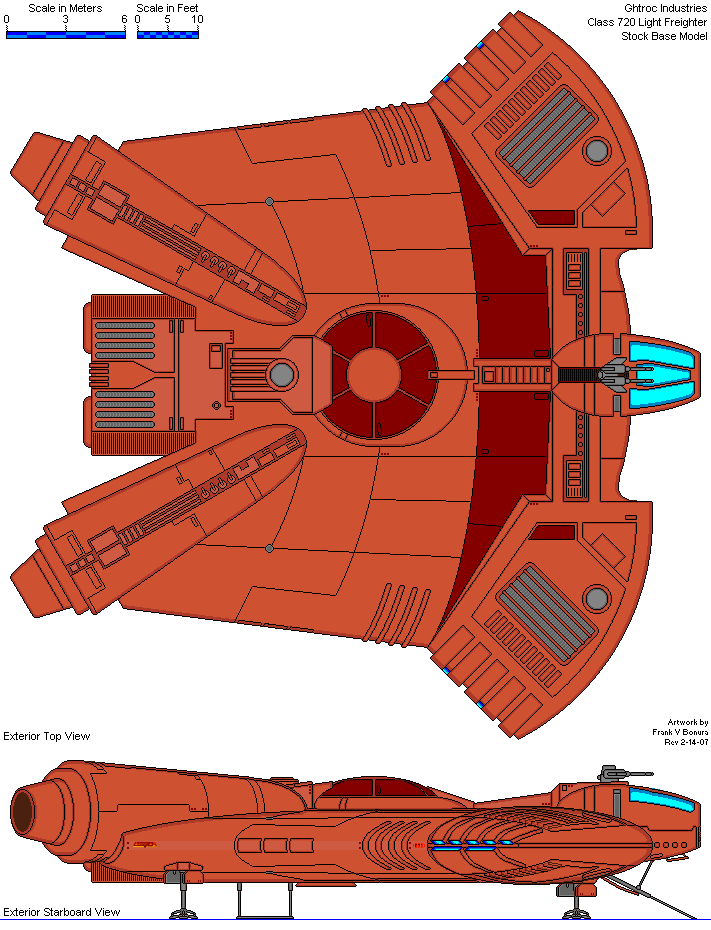
Capsule:A less popular, but no less durable freighter design, the Ghtroc freighter model became popular in the Outer Rim Territories, where the manufacturera was based. While Ghtroc Industries has since gone out of business, several thousand of the freighters remain in service, especially for simple cargo runs, where combat is not expected.
— “Star Wars® The Roleplaying Game”, Second Edition, p. 121,
— “The Star Wars® Roleplaying Game”, Second Edition, Revised and Expanded, p, 256
Ghtroc 720 Freighter
The Ghtroc Industries 720 is not as popular as the YT-1300, though it's still just as good. It was extensively used in the Outer Rim Territories, where the now dissolved starship companya was based. Ghtroc Industries designed the 720 tob upgrade the systems on its 580 light freighter, and to compete with Corellian Engineering's transport — it comes close in some areas, while being slightly deficient in others. The 720 was widely used to haul essential goods from the Outer Rim's commerce centers to outlying colonies. Free-traders found the ships to be affordable and well-suited for small-scale cargo runs to backwater settlements. Though the manufacturera has since gone out of business, several thousand Ghtrocsc are still in service throughout the galaxy. Parts for the ship are still plentiful,c and just as easily jury-rigged as those for the Corellian transport.1
The stock Ghtroc is generally a more sound vessel than the YT-1300. It has shields — though they're not too powerful — the maneuvering system is better, and there's more room in the hold. Larger size isn't always a benefit: the slow ion drives strain to push the transport anywhere. The double laser cannon is on a fixed mount forwardd — the Ghtroc's size make it difficult to line up your field of fire,d even with the greater maneuverability. Most owners take advantage of the superstructure configuration amidships to add a dorsal and ventral turret gun. They're best at cargo runs, and aren't as effective in combat as the YT-1300.
Unlike the Corellian transports, Ghtrocs have no variation in cockpit configuration — they're centrally mounted. Crew quarters, cargo bays and escape pods are oriented around a central power core. Since the ion drives are both up front and in the aft with the hyperdrives, engineering spaces are spread out. It's nice having some of the subspace engines close to the cockpit in case you need to effect hasty repairs in a fight, but you'll make it up when you have to split your attention between fore and aft when the hyperdrives or the rear ion drives go, too.e I'd much rather have all the technical access for both drives in one place, even if it is in the back.
— “Platt's Smugglers Guide”, pp. 32-33
Ghtroc 720
— “Star Wars® The Roleplaying Game”, Second Edition, page 121
- Craft: Ghtroc Industries class 720 freighter
- Type: Stock light freighter
- Scale: Starfighter
- Length: 35 meters
- Crew Skill: Space transports: Ghtroc 720
- Crew: 1 or 2 (can coordinate)d
- Passengers: 10
- Cargo capacity: 135 metric tons
- Consumables: 2 months
- Cost: 98,500 (new),a 23,000 (used)
- Hyperdrive Multiplier: x2
- Hyperdrive Backup: x15
- Nav Computer: Yes
- Maneuverability: 1D
- Space: 3
- Atmosphere: 260; 750 kmh
- Hull: 3D+2
- Shields: 1D
- Sensors:
- Passive: 15/0D
- Scan: 30/1D
- Search: 50/3D
- Focus: 2/4D
- Weapons:
- 1 Double Laser Cannon
- Fire Arc:Frontd
- Skill: Starship gunnery
- Fire Control: 1D+2
- Space Range: 1-3/12/25
- Atmosphere Range: 100-300/1.2/2.5km
- Damage: 4D
towas missing from this sentence in the original source and is believed to be a typo.
several thousand Ghtrocsis a very rough estimate at best. Based on 21st century Earth fabrication technology, we estimate that if the Ghtroc 720 was produced for several years, there could be as many as 30,000 Ghtroc 720s still in service in the RPG game setting.
Crew: 1 or 2 (can coordinate)was replaced in later publications with
Crew: 1, gunners: 1. This is believed to be a typo because all sources indicate the stock Double Laser Cannon is mounted in a fixed-front firing position and can only be aimed by the pilot maneuvering the ship.
“Since the ion drives are up front and the hyperdrives are aft, engineering spaces are spread out. It's nice having the subspace engines close to the cockpit in case you need to effect hasty repairs in a fight, but you'll make it up when you have to split your attention between fore and aft when the hyperdrives go, too.” — “Platt's Smugglers Guide”, pp. 32-33 (sic)However this statement is contradicted by the artwork in three other sources:

Unless otherwise noted, this deck has a maximum ceiling height of 2.29 meters (7ft 6in) in the cargo holds and 2.03 meters (6ft 8 in) in the crew and passenger areas. Descriptions of the lower deck's various rooms and compartments are listed below.
The "chin" houses the ship's entry ramp and forward airlock. This airlock is fully functional and can be used for space walks. The ramp is coated with a high-traction surface to prevent slips and falls. When lowered to the ground, the ramp is pitched at an angle to facilitate wheeled and tracked droids or other similar loading equipment. The ramp when lowered is rated at 700 kilograms and can lift to the closed position the same weight. Races or droids of greater weight than 700 kilograms should employ the cargo lift in the aft of the ship for entrance and egress.
The outer "chin", "shoulders" and "epaulets" contain the ship's sensors and communication equipment. This equipment can be accessed and serviced through access doors in the entry ramp room.
Working conditions in the Sensor Compartment are difficult for human-sized technicians due to the lack of insulation (frequent and rapid extremes of hot and cold), lack of radiation shielding, and tight working conditions. The compartment is better suited for droid or technicians wearing an environment suit if prolonged or extensive service and maintenance is required. The following standard equipment is installed in this compartment:
| Passive Sensor Array: Part Number: GHT0700-SP-S17413 | Search Scan Array: Part Number: GHT0700-SA-S27412 | Forward Search Sensor Array: Part Number: GHT0700-SS-S37417-EA | Starboard Search Sensor Array: Part Number: GHT0700-SS-S37417-EB Wave Guide: Part Number: GHT0700-SS-W37002 |
| Aft Search Sensor Array: Part Number: GHT0700-SS-S37417-EC Wave Guide: Part Number: GHT0700-SS-W37002 |
Port Search Sensor Array: Part Number: GHT0700-SS-S37417-ED Wave Guide: Part Number: GHT0700-SS-W37002 |
Focus Sensor Array: Part Number: GHT0700-SF-S37414 | Ship-to-Ship Communications Array: Part Number: GHT0700-TS-STS7411 |
The forward "fins" house the ship's ion maneuvering thrusters, forward/flanking shields (projectors, Controllers, and generators), and the ship's batteries. Also housed here are some of the ship's consumable storage tanks, fuel tanks, and fueling pumps. All can be accessed for service or maintenance by the doors at the ends of the forward corridors.
A space rated bulkhead and door separates the shield generator from the rest of the compartment. This is to prevent depressurization of the rest of the compartment in the event the shield generator is targeted and destroyed.
Work room is abundant in this compartment providing easy access to both the human-sized technician as well as the service maintenance droid. During normal operations, the Forward Mechanical Rooms will be some the the warmest compartments of the ship. The following standard equipment is installed in this compartment:
| Port Forward Thruster Bank: Part Number: GHT0700-RD-T45111 (5 per side) | Port Ion Drive and Control Unit: Part Number: GHT0700-RD-C68425 | Port Heat Diffuser (above): Part Number: GHT0700-RD-R14789 Port Forward Fuel Cell Bank (below): Fuel Cell Part Number: GHT0064-FC-ST0043 |
| Port Outer Liquid Protein Storage Bank: Tank Part Number: GHT0700-CS-T87281 (7 in bank) (radiation-shielded) | Port Forward Deflector Shield Projector: Part Number: GHT0700-DS-P02548 Port Side Battery Module: Part Number: GHT0021-BT-B00401 |
Port Forward Fluidics Storage: Part Number: GHT0700-FS-HD0097 (Hyperdrive Reactant) Port Forward Delivery Pump: Part Number: GHT0700-DP-M83591 |
| Port Inner Liquid Protein Storage Bank: Tank Part Number: GHT0700-CS-T87281 (5 in bank) (radiation-shielded) | Acceleration Compensator: Part Number: GHT0700-ID-A41112 Wave Guide: Part Number: GHT0700-SS-W37004 Deflector Shield Generator: Part Number: GHT0700-DS-G00972 |
Port Inertial Dampener Control: Part Number: GHT0700-ID-I35522 Port Forward Deflector Shield Controller: Part Number: GHT0700-DS-C04428 |
Behind the forward "fins" are two small compartments (port and starboard) that house the booster coils for the ship's hyperdrive. Part Numbers: GHT0700-SD-H7332L and GHT0700-SD-H7332R respectively. A skillful pilot could shoot here and cripple the ship's hyperdrive with minimal damage to the rest of the vessel. Due to all the fluidics conduit, movement through this room should be considered of Moderate difficulty. Droids without human-like legs should treat this area as Difficult terrain.
Behind the Sensor Compartment are a series of rooms. They contain the forward landing gear rooms (port and starboard), the premium passenger berths (bedrooms), and the central foyer. This section of the ship is equipped with the most sound and vibration-absorbing systems thus providing the most comfortable travel conditions on the ship. During typical flight operations, this area will see the most passenger and crew traffic due to its relative central location, proximity to vital ship systems and public-usage compartments.
The forward landing gear rooms can be accessed from the Forward Corridors. The doors to these compartments are a reinforced blast door intended to prevent decompression in the event the outer landing gear door is damaged. It is possible but not recommended to use this compartment as a makeshift airlock in the event of an emergency. Forward Landing Strut Assemblies are Part Numbers: GHT0700-UN-LS4523PF and GHT0700-UN-LS4523SF respectively. Ghtroc Industries recommends routine inspection of the Landing Strut Assemblies every 120 standard hours of normal ship operation.
The premium berths (bedrooms) each contain a set of bunk beds, 2 dressers, and 1 padded chair each. The room locations provide the least noise and vibration for passengers comfort.
Located aft of the entry ramp. A second ramp to the upper deck lowers from the ceiling in this compartment to provide access to the cockpit above. When lowered the areas outside the caution stripes form an oval shaped path to walk around the lowered ramp.
The ramp is coated with a high-traction surface to prevent slips and falls. When lowered to the lower deck, the ramp is pitched at an angle to facilitate wheeled and tracked droids or other similar loading equipment. The ramp when lowered is rated at 700 kilograms and can lift to the closed position the same weight. Races or droids of greater weight than 700 kilograms should remain on the lower deck.
Located port and starboard of the foyer. On the aft faces of the forward corridors are access to the cargo holds (port and starboard) and the crew berths (bedrooms).
The crew berths (bedrooms) are quite spacious and provide private rooms for both pilot and co-pilot. They contain 1 bed, 1 dresser, 1 wardrobe, 1 padded chair, and 1 small wall-mounted desk each. Noise and vibration in these rooms are almost as good as the premium berths.
Located aft of the port crew berth the galley (kitchen), is designed to deal with 2 crew and 10 passengers as long as all don't try to eat at the same time. The galley has 1 food processor, seating for 8, 1 refrigerator and 1 pantry.
Located aft of the starboard crew berth, the head (fresher - bathroom) is designed to deal with 2 crew and 10 passengers as long as all don't try to bathe, wash, or use the toilets all at the same time. The head has 2 sinks, 3 toilets, 1 single and 1 double shower.
At the very center of the ship is the power core. Its central location provides for the shortest possible distance for power to be distributed to the forward and aft thrusters as well as all ship systems requiring power. The ship's main reactor is so large, it extends to the upper deck and is surrounded by a ring corridor.
Allows access forward to the ship's galley, port or starboard cargo holds, port or starboard economy berths, and aft to the ship's cargo loader.
The aft hatch is a heavy blast door rated to withstand the explosive decompression of the cargo lift compartment behind it. If the outer hatch and cargo lift are extended into the vacuum of space, the aft door will automatically lock and warning flashers will strobe to prevent accidental decompression of the ship. The automatic lockout can be manually overridden at the aft door's control panel or from the cockpit.
Located port and starboard of the ring corridor, the cargo holds can be accessed from varrous points on the lower deck. The holds have a maximum ceiling height of 2.29 meters (7ft 6in). Ceiling hight can accommodate most smaller wheeled or tracked cargo loading equipment or droids. Maximum recommended stack height is two one meter high cargo containers or one two meter high cargo container so as to prevent damage to the ceiling of the cargo hold when moving and loading freight.
The holds are designed to transport dozens of cargo pallets, speeder bikes, swoops-sized objects, or can hold many car-sized ground vehicles, or several speeders in each.
Each cargo hold has a total of 225 cubic meters of storage space. The holds can be loaded from the cargo lift room, or the aft loading rooms.
The ceilings of the holds have many pull-down hatches equipped with fold-down ladders for accent, to facilitate system repairs, maintenance, and replacement of fuel cells. The grill-works on the deck of the holds are removable allowing access to the ship's massive repulsorlift systems for repair and maintenance.
Warning: Numerous holds and tie-down points are located throughout the cargo holds to allow for mechanical blocking and bracing of cargo loads during flight. Ghtroc Industries recommends that all cargo be secured and properly tied down and that all cargo loads be balanced evenly between both cargo holds. Ship performance can be drastically degraded if flown with an imbalanced cargo load. Please consult your Ghtroc Industries Class 720 Operators Manual under “Cargo Loading Procedures” for more information.
Within each cargo hold, caution stripes on the floor indicate “No Load” areas to allow passengers and crew access to the escape pods. The escape pods are accessed from pull-down hatches in the ceiling equipped with fold-down ladders for accent into the pod.
A loading lift is also located in this area for use with droids, or other passengers who can not climb a ladder. The escape lift is marked with caution stripes, and can lift 1 metric ton in 2 seconds to the escape pod if the emergency mode is used. The lift has its own power supply and will function even if the ship's main power core is offline.
Warning: Areas within the cargo hold marked with caution stipes should not have freight or equipment placed on them during flight. These areas are to be left clear for access to the ship's escape pod systems. Failure to comply with these directives can result in operator and passenger deaths. Please consult your Ghtroc Industries Class 720 Operators Manual under “Escape Equipment” for more information.
Located port aft or starboard aft of the ring corridor. These rooms contain 3 beds (1 normal, 2 bunk), and one tall dresser. These rooms are not frequently used for passengers. Spacers tend to use them for storage due to the noise and vibration encountered here. The single bed can fold up against the wall to make the room suitable to accommodate larger alien races that don't mind sleeping on the floor.
Located aft of the ring corridor. This area houses the ships main cargo lift. The lift's outer sliding door is double sealed and can serve as a fully functioning airlock for space walks or pickup and delivery in a vacuum. Rated to safely lift 4 metric tons, the Cargo Lift has access only to the lower deck and under the ship. The lift can fit containers or objects of a maximum size of 2.24 meters (7ft 4in) wide, by 6 meters (19ft 8in) long, by 2.27 meters (7ft 5in) high.
Note: Objects of maximum hight limits require specialized loading docks with recessed floors to load containers. If loading on a flat surface, the lift's max hight limitation is only 1.68 meters (5ft 6in).
Located aft of the cargo lift room at the very aft of the ship's “tail”. This compartment houses the ship's main hyperdrive, backup hyperdrive, main ion drives, main thrusters, aft hyperdrive booster modules, and inertial dampener. Floor grilles in this area allow for access beneath these systems for inspection and maintenance. The following standard equipment is installed in this compartment:
| Main Hyperdrive: Part Number: GHT0700-SD-H00712 | Backup Hyperdrive: Part Number: GHT0700-SD-H00082B | Main Ion Drive Control Unit: Part Number: GHT0700-RD-C06161L and GHT0700-RD-C06161R (2 in bank) |
| Main Thruster: Part Number: GHT0700-RD-T21777L and GHT0700-RD-T21777R (2 in bank) | Hyperdrive Booster Coil: Part Number: GHT0700-SD-H7321L and GHT0700-SD-H7321R (2 in bank) | Aft Inertial Dampener: Part Number: GHT0700-ID-I33818 Wave Guide: Part Number: GHT0700-SS-W37015 |
These two compartments can be accessed from the Aft Loading Rooms. The access doors to these compartments are a reinforced blast door intended to prevent decompression in the event the outer landing gear door(s) are damaged. It is possible but not recommended to use this compartment as a makeshift airlock in the event of an emergency. Aft Landing Strut Assemblies are Part Numbers: GHT0700-UN-LS4523PA and GHT0700-UN-LS4523SA respectively. Ghtroc Industries recommends routine inspection of the Landing Strut Assemblies every 120 standard hours of normal ship operation.
Located aft of the cargo holds at the ship's " rear fins". Ramps from the above deck provide access to the upper docking rings and allow freight to be slid down to the cargo holds. When raised, these ramps form the launch track for the escape pods above. These rooms also house various mechanicals and consumables tanks that are vital to ship operation and escape pod operation. The following standard equipment is installed in this compartment:
| Cold Water Storage: Part Numbers (Port Bank): GHT0700-CS-WT4784P, GHT0700-CS-WT4785P, GHT0700-CS-WT4786P (3 in bank) Lifter Pump and Water Manifold: Part Number: GHT0700-DP-W82115 Water Heaters and Pressure Pumps: Part Number: GHT0700-PP-W88672 |
Hot Water Storage: Part Number: GHT0700-CS-WT5821P and GHT0700-CS-WT5821S Pressure Pump and Heating Coil: Part Number: GHT0700-PP-W87414 Lifter Pump and Hot Water Manifold: Part Number: GHT0700-DP-WT83892 |
Port Aft Fluidics Storage: Part Number: GHT0700-FS-HD0091 (Hyperdrive Reactant) Port Aft Fluidics Delivery Pump: Part Number: GHT0700-DP-M71657 Fluidics Controller: Part Number: GHT0700-FC-HD13579 |
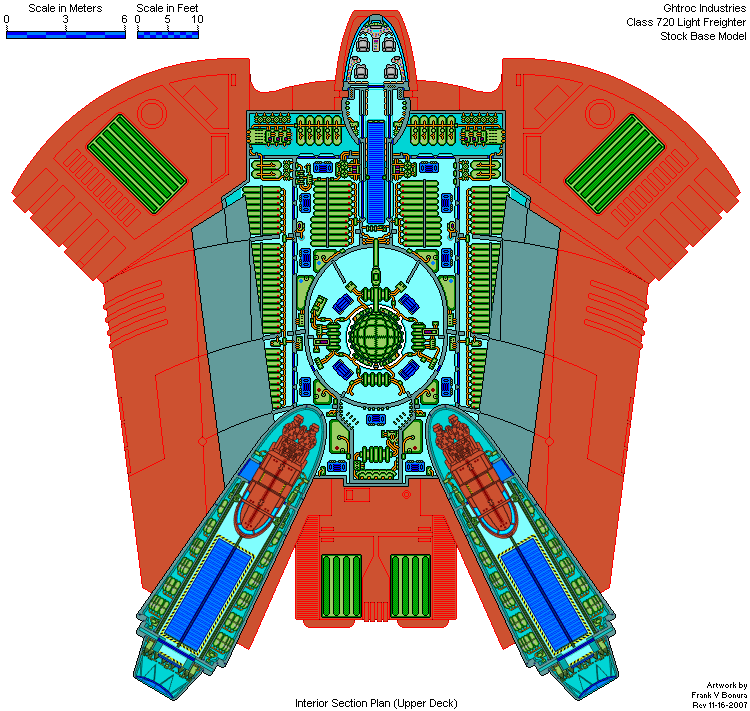
Unless otherwise noted, this deck has a maximum ceiling height of 2.29 meters (7ft 6in) headroom in the cockpit, and docking arms. The rest of the upper deck is mostly crawlspaces with little more than 3' of headroom. The bulk of the 720's upper deck store the ship's fuel and consumables. Descriptions of its various rooms and compartments are listed below.
Located in the " head". The cockpit is equipped with 4 control stations. The 2 forward control stations can perform all ship functions; the 2 aft control stations can control: life support, docking, loading, shields, sensors, and communication systems.
Located behind the cockpit to either side of the ramp compartment, these curved rooms house the ship's fire controls and avionics systems. If you are wondering why these rooms seem so empty, its because they were designed for upgrades to weapon and avionic controls.
Located aft of the cockpit in the " neck". This ramp is fully sealed preventing de pressurization between decks. This upper ramp lowers to provide access to and from the central foyer in the deck below. This ramp allows astromech droids access to the cockpit. In the aft end of this compartment are the ship's main wiring trunks, the ramp control motor, and hydraulic pump.
Located in the " shoulders" to either side of the cockpit. These compartments hold the ship's life support equipment and atmosphere recyclers. Life support consumables are stored here as well.
Located to either side of the ramp compartment. These rooms house the ship's electrical system controls fuel cells, fuel pumps, weapon charging systems (port side), and consumables storage tanks. These rooms can be accessed from the ramp compartment or service panels in the floor. The power couplings that power the weapon charging systems on the port side have sister systems on the starboard side that are not used on the stock model. These couplings can be used for weapon upgrades that require more power.
Located in the center of the ship in the domed " shell". This compartment partially extends to the deck below. It houses the ship's upper power core and power converters. This compartment can be accessed from 4 service panels in the floor.
Located above the ship's cargo holds on either side of the ship. These compartments contain the bulk of the ship's fuel cells, and some life support equipment. These rooms can be accessed from the forward fuel compartments or service panels on the ceiling of the cargo holds below.
Located aft of the upper reactor room to either side. These rooms house additional ship consumables and electrical controls. These compartments can be accessed from 4 service panels in the floor (2 each).
Located directly aft of the upper reactor room. This room houses the aft shield projectors, shield Controllers, and shield generators. This compartment can be accessed from a single service panel in the floor.
Located at the very aft of the ship in the " Rear fins". These docking arms serve several functions: airlock, docking ring, and escape pod launcher. The decks of the docking arms form a ramp when lowered to allow freight to be moved to and from the cargo holds in the lower deck. The ramps when raised serve as launch tracks for the escape pods loaded in the docking arms. For complete details of the Class 700 Escape Pod used on the Ghtroc 720 please consult its respective entry on this website. The Docking arms are triple sealed and are suitable for space walks for exterior repairs. The docking rings are designed for universal magnetic seal coupling and will dock with any standard airlock for ship to ship docking and transfer. The escape pods are accessed from the lower deck via a pull-down hatch in the ceiling.
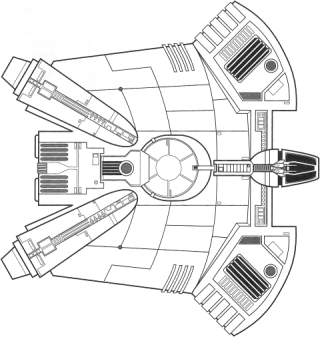
Clearly of all the light freighters in the roleplaying game, the Ghtroc 720 seems to be amongst the best represented. There was no difficulty finding plenty of examples of official artwork for a reference to base this project on. Where the project became a design challenge was finding common ground amongst all the source material. This may be one rare case where having too much information created a hindrance in producing a ship. Like with all our projects, we focused on the first and original image of the freighter and worked forward through all the source material looking for common elements and patterns.
Although the original artwork provided us with the most information, it was only part of the story and only a top view. To learn more about this ship we would have to look at artwork from other artists and incorporate their interpretations into the design. The top view was originally drawn by John Paul Lona but most drawings of the Ghtroc 720 would be drawn by Mike Vilardi who would shine light on the landing gear, plus aft, and side details of the exterior thus bringing the ship into the third dimension.
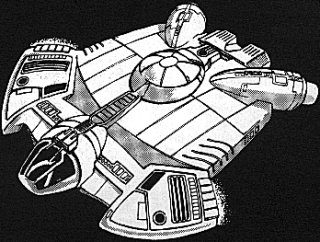
There are few images published by West End Games® or Dark Horse Comics® that fully collude with one another. It was decided to incorporate elements from all these images to produce an "averaged" exterior in which to base the deckplans.
We also decided that the original image possesses the most common features when compared to the body of evidence, and would dominate the project. From there we worked our way down forming a hierarchy of the images for their value as references. Where details matched or did not interfere with others, they were incorporated and when details conflicted with older references, they were omitted and/or moved/adjusted to accommodate others.
Note: Here we see the exhaust of sublight thrust on the Ghtroc 720 while moving with its front maneuvering thrusters in the front “fins”.
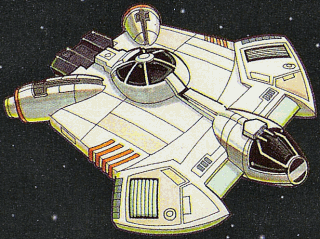
We noticed the Ghtroc 720 looked similar to a sea turtle so we decided to refer to parts of the ship in terms of a sea turtle's body. Thus the following structures were assigned body part names to assist in describing the various structures during construction:
Note: We make reference to all these part names on this deckplan page as well as other ships based on it.


The next step was tackling the side view. This was a bit of a problem because there was no official image or schematic of the side view on a stock Ghtroc 720. The only official a side view available was of the Shroud Freighter (a heavily modified Ghtroc Freighter) flown by Luke Skywalker and seen in both “The Last Command Sourcebook” page 134, and in “The Thrawn Trilogy Sourcebook” page 237. We proceeded by blending the images from “Platt's Starport Guide” page 29 with images of the Shroud Freighter to establish the elliptical curve of the hull's cross-section and the shape the hull forms where it attaches itself to the front “fins”.
Note: This is the first of the images that clearly demonstrate the Ghtroc 720 has sublight thrusters in the rear “tail” section and not just in the front “fins”.
We had noted the Shroud Freighter had an upper and lower level in the schematic but were not sure if this applied to the stock model as well. While developing the side view we did notice that the Ghtroc 720 was very tall (even without the Shroud modifications). Our conclusion was the freighter had two decks and not one as it was depicted in the official deckplan in “Platt's Smugglers Guide” page 40. Clearly the two sources conflicted with one another but in the end we realized the older source was correct. With the idea for the upper deck confirmed, we continued and incorporated the feature into the design.

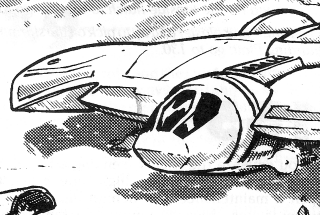
Some WEG drawings had epaulets on the ship's “shoulders”, and other images didn't. The majority did so they were added on the top view even though that particular reference image didn't have any. The epaulets give the leading edge of the shoulders a more aerodynamic profile. The 720 epaulets can best seen on the image from “Galaxy Guide 9 - Fragments From the Rim” page 15 and served as our primary reference for our model.
Note: The drawing of the Merry Thrubidor is the second image that clearly demonstrates the Ghtroc 720 has sublight thrusters in the rear “tail” section and not just in the front forward “fins” section.
There are many contours and small access hatches in the various images of the 720 so we attempted to draw all of them on the hull. Except in cases when contours contradicted one another, in which case we went with the contours that appeared in the most incidences.
Images of the Ghtroc 720 landed with landing gear extended are very rare and in this image we see one of the landing feet of the ship. This image was used as our primary landing gear reference for size shape and location on the project.
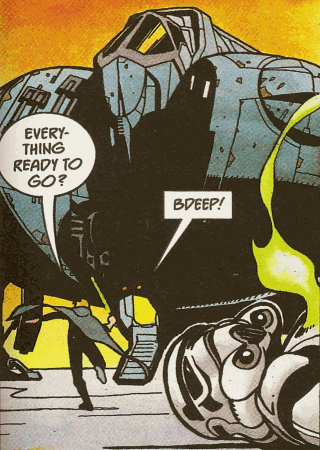

Dark Horse Comics® published a comic adaptation of the “Thrawn Trilogy” novels originally written by Timothy Zahn. Naturally we studied the last of these comics for within the “The Last Command” comics they also produced artwork for the Shroud Freighter (a heavily modified Ghtroc Freighter mentioned earlier) flown by Luke Skywalker.
The artwork in the comic adaptation greatly differed from the artwork in the roleplaying game and being that the RPG artwork was older, more internally-consistent, and more numerous in volume, the comic references only served a very tiny role in this project.
However the comics were not completely ignored. Where we did get use out of these images were in the landing gear and boarding ramp which were very similar to the older sources. Lastly we tried to use any useful minor details in areas where the older artwork was silent and where the comic references could enrich the overall aesthetic of the project.
Note: The Shroud Freighter of the comics is a very radical design as compared to the West End Games® artwork. However the image above clearly demonstrates the Ghtroc 720 has sublight thrusters in the rear.
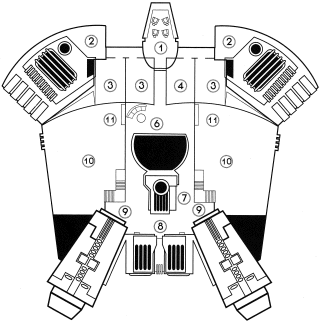
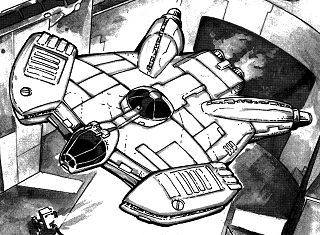
West End Games® did produce an official deckplan for the Ghtroc 720. The official deckplan was published around the same time we decided we needed a deckplan for this ship and when we looked at it, we decided to use it as a rough guide and would build something significantly better.
We decided to retain some elements of this official deckplan which include:
There were also many elements of this deckplan we decided to change and correct including:
Note: This is the third image that clearly demonstrates the Ghtroc 720 has sublight thrusters in the rear “tail” section and not just in the front “fins”. This image comes from the same sourcebook (“Platt's Smugglers Guide”) that incorrectly states the opposite in the deckplan descriptions and adjoining text.
In the end we had developed a very different deckplan from the official version. It was our intent to honor the original but at the same time transform it and elevate it to a much higher level of detail and functionality. The Ghtroc 720 viewed on this page is the outcome of that ongoing mission.




*NOTE: the “Luudrian Star” in “Star Wars®Adventure Journal” #2 page 283 is misspelled Class 729